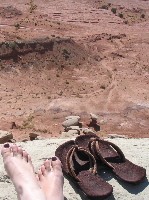Spectrographic Anecdotes
I spent most of today trying to compile a list of all of the spectrographs in the world (and in space). The primary conclusion I have come to thus far is that for the vast majority of observatories' websites, it is incredibly difficult to get a simple list of instrument specifications (e.g., what wavelength range does your spectrograph cover?). What especially amazes me is that this problem holds true for webpages that superficially look well thought and laid out. Yes, I'm naive, but life is quite cozy here under my little rock.
Then there are the webpages that simply won't load. The little wheel goes around and around and I wait and wait and eventually the connection times out. Shortly after I gave up on trying to access the Keck and the CFHT websites, Google headlines started including the Hawai'i 6.6 magnitude earthquake ... apparently power outtages and rampant destruction lead to webpages being down. Much much more importantly is the question of how those telescopes are doing: some of the largest telescopes in the world are on Mauna Kea, and Mauna Kea is frightfully close to the epicenter. I have not yet been able to glean any information from the web on how these telescopes are doing.
In happier news, apparently the Discovery Channel is in the process of constructing a telescope at Lowell Observatory. Also, there are apparently telescopes in/near Coonabarabran, Australia, which is excellent because "Coonabarabran" is a fun word to say. In fact, a quick Google search reveals that Coonabarabran is the "Astronomy Capital of Australia." Isn't that just hilarious??


1 comment:
If you need any information on the HERCULES spectrograph at Mt John observatory (New Zealand), I'd be happy to oblige. We recently upgraded the CCD to a 4K x 4K model. You can email me at trendyhendy2000 AT gmail DOT com.
- chris
Post a Comment